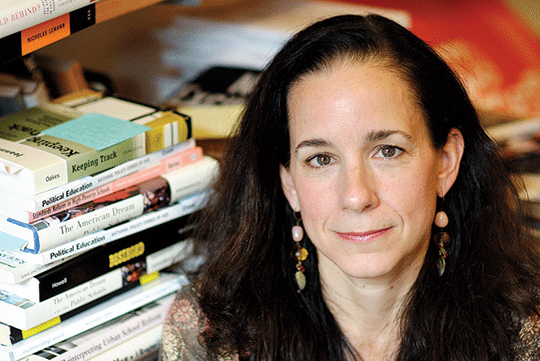TC's Amy Stuart Wells in the Worcester Telegram: Seeing Past the Colorblind Myth of Education Policy
The following article, by Clive McFarlane, was originally published in the Worcester Telegram.
Does race color our behaviors?
We shouldn't be too surprised that sometimes our words convey more than one meaning.
After all, our individual experiences — socially, economically or otherwise — often dictate how we see and view the world.
Context, then, is central to decoding the meaning behind what we say to each other. Take the word "colorblind," which is stirring such consternation in our local discourse around education.
To some the term is a fundamental democratic principle governing how we see each other. None other than civil rights leader Martin Luther King Jr., we are told, embraced it as a guiding principle when he said a person should be judged by the content of his character and not by the color of his skin.
Yet, colorblind as an ideal is different from colorblind as a reality. It is one thing, for example, to say we want our justice system to be colorblind; it is another to say it is. It is one thing to say you want to be colorblind; it is another to say you are.
This deconstruction of the term is essential if we are to make meaningful progress moving toward a just community, according to educators such as Sarah Michaels, a Clark University professor and senior research scholar at the Hiatt Center for Urban Education.
"I think that it would be a far better world if racism did not exist, and no one noticed color and no one was denied access to social goods because of it," according to Ms. Michaels.
"But that, sadly, is not the world we live in," she said.
"To claim that someone is 'color blind' (meaning they are not racist or biased or prejudiced in any way) is denying the fact that we live in a world where race and racism is still very much alive and that many suffer its consequences on a daily basis."
In her view, Ms. Michaels, who has had a focus on teacher education, educational research on classroom discourse and district-based education reform efforts, "none of us in this society is blind to color, because race and racism permeate our country and world — in large and small ways."
And according to her, "If you don't acknowledge that racism is still a powerful force in this society — both consciously and unconsciously, both at the individual level and at the institutional level, and if you don't acknowledge that there is something like white privilege that many well-meaning, and so-called 'enlightened' or 'anti-racist' folks benefit from — you are missing or ignoring much of the problem, and even guilty of colluding in perpetuating the problem."
In a National Education Policy Center brief published last year and titled "Seeing Past the 'Colorblind' Myth of Education Policy," Amy Stuart Wells of Teachers College, Columbia University, looked at how housing markets, school district boundaries and accountability systems, among other factors, "are actually far from colorblind in their impact on the public education system."
"Even when education policies are colorblind on the surface, they interact with school systems and residential patterns in which race is a central factor in deciding where students go to school, what resources and curricula they have access to, whether they are understood and appreciated by their teachers and classmates and how they are categorized across academic programs," she wrote.
This view is not so radical, and it shouldn't be as threatening as some see it. If a colorblind society is indeed the ideal, then we shouldn't be afraid to reflect on whether race and ethnicity are coloring our individual and institutional behaviors.
Published Thursday, Apr. 9, 2015
